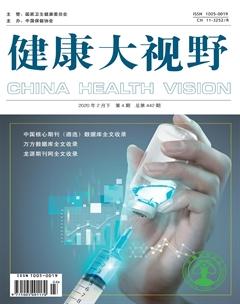乳腺超声假阴性乳腺癌的临床分析
张金慧
【摘 要】目的:通过研究与分析在采用乳腺超声技术对假阴性乳腺癌与真阳性乳腺癌进行临床诊断时,临床中的差异,并基于此对假阴性乳腺癌疾病的临床特点进行统计。方法:对采用乳腺超声诊断技术的328例乳腺癌患者分组研究,分别为研究组与对照组。采用回顾性分析的方式对两组患者的诊疗信息以及病历资料等进行统计分析,对比其中患者的患病年龄,绝经情况等相关信息,再利用乳腺超声技术检验其的关系。结果:在所有乳腺癌患者中,假阴性乳腺癌的比例为6.71%。在对两者患者的年龄统计分析中,中青年患者患有假阴性乳腺癌疾病的几率较高。在对患病的位置分析时,乳晕部位出现假阴性乳腺疾病的几率较高,p<0.05。在对患者的绝经情况分析时,P>0.05。结论:当患者的年龄在40以下,处在中青年阶段,乳晕部位发生假阴性乳腺癌疾病的几率相对较高,可以基于此为假性乳腺癌疾病的诊断提供有价值的指导。
【关键词】乳腺超声;假阴性乳腺癌;真阳性乳腺癌;临床特点
Abstract:Objective To study and analyze the differences in clinical diagnosis between false negative breast cancer and true positive breast cancer by breast ultrasonography, and to analyze the clinical characteristics of false negative breast cancer. Methods: 328 breast cancer patients were divided into study group and control group by using breast supernatant diagnosis technology. A retrospective analysis was used to analyze the diagnosis and treatment information and medical records of the two groups. The age and menopausal status of the patients were compared, and the relationship between the two groups was examined by breast ultrasound. Results: In all breast cancer patients, the proportion of false negative breast cancer was 6.71%. In the statistical analysis of the age of the two patients, young and middle-aged patients have a higher incidence of pseudo-negative breast cancer. In the analysis of the location of the disease, the incidence of false negative breast diseases in areola was higher, P < 0.05. In the analysis of menopause, P > 0.05. CONCLUSION: When the patients are under 40 years old and in the middle-aged and young stage, the incidence of pseudo-negative breast cancer in areola is relatively high, which can provide valuable guidance for the diagnosis of pseudo-breast cancer.
Key words: breast ultrasound; false negative breast cancer; true positive breast cancer; clinical characteristics
【中图分类号】R814.41【文献标识码】A【文章编号】1005-0019(2020)04--02
超声诊断的方式由于其显著的应用优势,在对乳腺癌疾病的临床诊断中,应用较为广泛,并且达到了一定的应用效果。但是在临床中,由于假阴性乳腺癌疾病与真阳性乳腺癌疾病之间存在的相似性,容易导致诊断结果失误,对部分假阴性乳腺癌疾病出现漏诊的情况,进一步影响疾病的治疗以及患者生命安全的保障[1]。因此,在临床中如何正确的诊断假阴性乳腺癌与真阳性乳腺癌疾病,并在此基础上给予患者针对性的治疗,是保障患者身体健康与生命安全重要的方式。为了研究与分析在采用乳腺超声技术对假阴性乳腺癌与真阳性乳腺癌进行临床诊断时,临床中的差异并基于此对假阴性乳腺癌疾病的临床特点进行统计。本文主要对2018年4月份-2019年3月份期间在本月采用乳腺超声诊断技术的328例乳腺癌患者分组研究,并对诊断的结果统计对比,具体流程如下:
1 研究对象与研究方法
1.1 研究对象一般资料
这次研究主要针对2018年4月份-2019年3月份期间在本月采用乳腺超声诊断技术的328例乳腺癌患者分组研究,其中假阴性乳腺癌與真阳性乳腺癌患者分别为研究组与对照组。
1.2 方法
在此次研究中采用彩色多普勒超声诊断仪进行检查,患者的检查姿势为仰卧位,将上肢具体以便乳房以及相关检查部位暴露出来,采用以乳头为中心的扫描检查方式[2]。
1.3 评价标准
采用回顾性分析的方式对两组患者的诊疗信息以及病历资料等进行统计分析,对比其中患者的患病年龄,绝经情况等相关信息,再利用乳腺超声技术检验其的关系。
2 结果
在所有乳腺癌患者中,研究组与对照组的数量分别为22例与306例,假阴性乳腺癌的比例为6.71%。在对两组患者的年龄统计分析中,研究组与对照组年龄在40岁以下患者的数量分别为5例与26例,年龄在40岁以下的发病几率分别为22.73%与8.50%,中青年患者患有假阴性乳腺癌疾病的几率较高,p<0.05。在对患病的位置分析时,研究组与对照组患者发病部位为乳晕区几率分别为31.82%与12.09%,乳晕部位出现假阴性乳腺疾病的几率较高,p<0.05。在对患者的绝经情况分析时,P>0.05。
3 讨论
当患者的年龄在40以下,处在中青年阶段,乳晕部位发生假阴性乳腺癌疾病的几率相对较高,可以基于此为假性乳腺癌疾病的诊断提供有价值的指导。
参考文献
刘洋. 钼靶X线与彩色多普勒超声对乳腺癌合并细微钙化影像特点分析[J]. 深圳中西医结合杂志, 2017.
吴芳, 成静, 马婷, et al. 乳腺癌超声征象对乳腺癌分子分型的临床预判分析[J]. 中外女性健康研究, 2018(23):9-10+122.
贾志莺, 张银华, 冷晓玲, et al. 三阴性及非三阴性乳腺癌超声、临床病理特征的回顾性分析[J]. 中国临床医学影像杂志, 2017(1):23-26,共4页.

